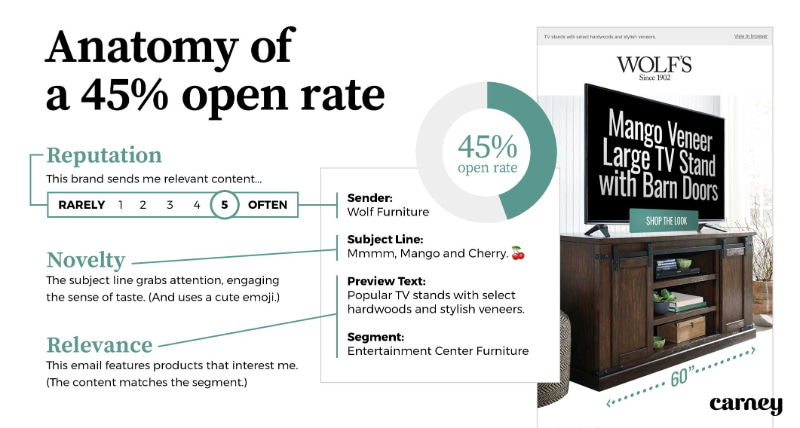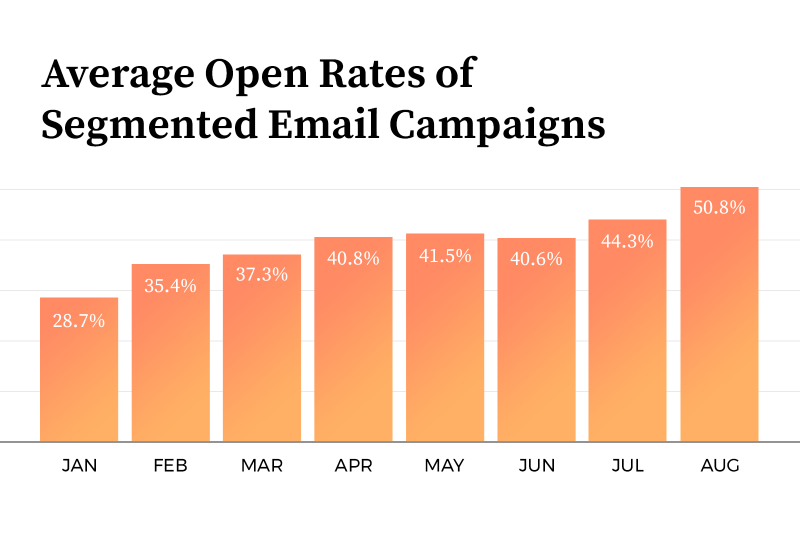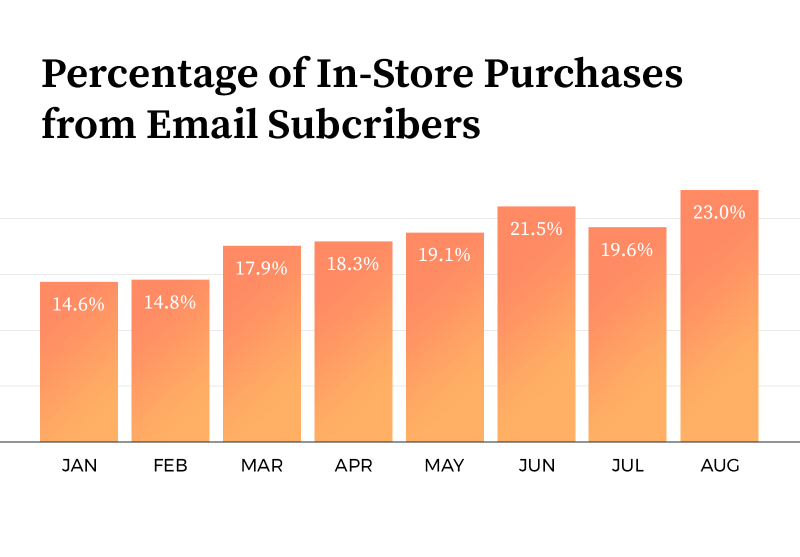What goes through a subscriber’s mind those first nanoseconds after they see your brand in their inbox?
What runs through your mind when you see someone else’s brand appear in your inbox?
A study by Litmus and Fluent found that 42% say they consciously look at the sender name first when deciding whether or not to open an email. But being honest with ourselves, subconsciously we all associate a brand name with our cumulative experience with that brand.
The implication: No email campaign―and no subject line―exists in a vacuum. It is just one point of contact between customers and their larger experience with your brand.
As an email marketer, you may not have control over every detail of your brand’s reputation outside the inbox. But at the very least you can and should control your brand’s reputation inside the inbox.
As we’re using the term here, your inbox reputation is essentially the answer to this question:
Q: To what degree do subscribers anticipate receiving relevant content in my emails?

In a sense, only your subscribers can answer that question. Their perception is your inbox reputation reality. How personally relevant did they find your last email? What about the five emails before that? That dictates what they instinctively anticipate the next time your name shows up in their inbox.
So let’s ask the question another way, focusing on what you can control:
Q: How consistently do I deliver the right content to the right subscribers?
Sending the same email to all of your subscribers, all of the time undermines relevance. Undermining relevance undermines reputation. Even if they love your brand, your subscribers are less likely to find your email marketing personally relevant.
So what can be done to improve? Let’s address each of the following:
1) THE TOOL: “An elegant weapon for a more civilized age.”
The tool we must get comfortable with is the segmented email campaign. This is the lightsaber of digital marketing. To quote Obi-Wan Kenobi, “…not as clumsy or random as a blaster. An elegant weapon, for a more civilized age.”
Segmented emails have the power to accomplish what an email blast to an entire list never could: deliver relevant content to the right subscribers.
But it’s not enough to have the right tool, you’ll also need the right mindset…
2) THE MINDSET: Relevance + Consistency = Improved Reputation
It’s not enough to simply send segmented emails from time to time and marvel at individual email open rates.
Without consistency, a single relevant email will seem just as ‘clumsy or random as a blaster’. As in: ‘Wow, they sent me something I’m interested in…1 time out of 10…Doesn’t seem like they get me…’
As email marketers, we need to discard the idea that we can please all of the people all of the time (a clear impossibility). Instead, we need to focus on pleasing some of the people most of the time (something far more obtainable and rewarding).
So, how do we take our tool and our mindset and put it to work?
3) THE METHOD: Segment & Match. Analyze. Repeat.
You don’t have to achieve Amazon-like omniscience to consistently send relevant emails. While email service providers vary, start with whatever ways you can slice and dice your list and track your subscribers’ behavior.
Segment & Match
The process of matching segments with relevant content can work in two directions. You will probably want to use a combination of both directions to generate the most campaign ideas.
1) Let your segments inform your content: Identify a major segment of your list. Ask yourself:
- What do I know about this segment of people?
- What can I infer about their motivation?
- What content can I curate (or create) that is specifically relevant to this segment?
Examples:
- I can segment by browsing/click habits. What products or services would appeal to subscribers who have already clicked on a specific product category?
- I can segment by predicted demographics. What products or services would appeal to subscribers of a certain age or gender?
2) Let your content inform your segments: You have a great piece of content that is relevant to specific customers. Ask yourself:
- Is this content really “for everyone”? Or is this content less relevant for some subscribers and much more relevant for others?
- What segment could I create to deliver this content to the right subscribers?
Examples:
- I have a line of accessories for a specific type of product. Can I create a segment of people who have viewed, clicked on, or purchased that product?
- I have a great series of blog articles with tips for working mothers. Can I create a segment of subscribers who are most likely to be interested in that content?
Analyze
Keep your eye on the results. Is a certain audience less engaged than you anticipated? Could your content have been more relevant?
On one hand, don’t set it and forget it. On the other hand, don’t overreact to the performance of an individual campaign. Monitor your segments over time to get a sense of what’s working and what’s not.
Beyond keeping an eye on open rates and click rates, take a broader view to determine what your audience finds relevant:
- Email Analytics: What content within each email is capturing the most engagement?
- Website Analytics: What content is trending on your website? Are there variations based on demographics? Is some content particularly popular to visitors coming to your website from your email channel?
- Surveys: Sometimes the simplest way to determine what is relevant―what people are really looking for―is to ask them. Yeah, just ask them. Crazy idea, right? Many email service providers have integrated survey tools that can make the process quick and relatively painless.
Repeat
Don’t just segment from time to time. Do the hard thing. Segment relevant content consistently.
Let’s pull back the curtain and see an example of how this works in practice.
4. THE RESULTS: How we improved a retail client’s inbox reputation
As a furniture retailer, Wolf’s has a broad range of products for every room in the house. And because furnishing a room isn’t something you do every day, customers may go months, if not years, between purchases.
Sending everyone the same content at the same frequency was a clear path toward sending poorly timed emails featuring less than relevant products. A pattern of this over time would only lead to poor open rates, needless unsubscribes, and spam reports.
Enter the segmented email.
We began using segmenting to send active shoppers campaigns featuring products, styles, and offers in which they had already demonstrated active interest.
Subject lines and preview text were purposefully crafted to include references to the relevant interest. Not surprisingly, these segmented email campaigns consistently achieved open and click rates well above the list’s average.
In the beginning, we sent about 1 segmented email for every 2 emails to the entire list. But then we shifted the ratio. Over an eight-month period we sent between 3 to 5 segmented emails for every 1 email to the entire list.
What happened to the open rates of the segmented email campaigns? We saw a 22% lift in open rates for our segmented campaigns.

It wasn’t just that individual emails were performing well. An expectation was being set: An email from Wolf’s is an email I’m likely to be interested in. As the inbox reputation improved, open rates improved.
But what about outside the inbox? Were these emails contributing toward business objectives?
A large part of Wolf’s business comes from their brick and mortar stores. Many customers research online, but they still want to come to the store, recline in the recliner, chill on the chaise, operate the ottoman…er, you get the idea.
Was there any correlation between increasing the frequency of relevant, segmented emails and in-store sales?

During that same eight-month period, the percentage of in-store purchases made by email subscribers also increased, approaching one-quarter of in-store purchases. Sending relevant emails to active shoppers was keeping Wolf’s top of mind for furniture shopping.
But how can you make this work in practice? Isn’t this all easier said than done?
5. THE OBJECTIONS: This sounds great, but…
Understanding the value of consistently delivering relevant emails is one thing. Implementing this approach is another.
How can we address and overcome some of the common obstacles to implementation, especially if we’re in the position of persuading skeptical decision makers?
Objection One: But if we have such a great piece of content, why wouldn’t we send it to our entire list “just in case” more people are interested?
It’s tempting to think that you can send a given campaign to a limitless number of subscribers at “no extra cost,” which leads to the notion you should send every campaign to as many people as possible.
However, this isn’t simply a cost-per-piece issue. There is a serious cost to sending campaigns to subscribers who aren’t interested.
While we have been talking about inbox reputation from a psychological point of view, email clients are looking at it from a technological point of view. And here we find a significant difference between snail mail and email.
Your friendly neighborhood postal worker doesn’t monitor how many people on a street throw away your printed flyer without reading it and then decide whether or not to even deliver the next flyer you send.
But in the war against spam email clients are doing this for your subscribers every day.
Consider this quote from Yahoo Mail’s industry standards and best practices:
“Monitor…inactive recipients. Persistent email to these addresses will get your connections deferred….Sending email to users who are not reading them, or who mark them as “spam,” will hurt your delivery metrics and reputation.”
Persistent emails to inactive recipients damages your reputation and increases the likelihood of emails ending up in spam folders. Which further decreases your open rates. Which further damages your reputation. Which increases the likelihood of emails ending up in spam folders…
Avoid even starting this vicious cycle.
- Gather a legitimate list of subscribers who actually want to hear from you.
- Create emails that your subscribers actually want to read.
- Send those emails to a segment of people who actually want to read them.
If you’re seeing a segment of unengaged users, analyze why they’re not responding. Establish what, if anything, they are interested in right now. Or when they might be interested again.
You may need to change up the content or the frequency for that segment.
You may need to remove them from your list entirely.
And that’s ok.
Don’t pay your email service provider extra for a bloated list of subscribers who have lost interest. Either identify what they’re looking for or let them go.
Remember: The power of email marketing is not getting in front of as many people as possible. It’s getting in front of as many of the right people as often as possible. Getting in front of the wrong people hurts your long-term success.
Objection Two: Our team doesn’t have the resources send out multiple, segmented campaigns. We need to stick to just one blast to everyone.
It’s true, we all work with a finite amount of resources, whether those resources are budget or team members or hours in the day. But let’s turn this objection around. Can you really afford not to send relevant emails to your subscribers?
Imagine having a salesperson with a long list of potential customers. These customers asked to be contacted. What’s more, the salesperson has a record of what they are shopping for. But this salesperson never follows up…with any of them. Refuses to do it, even when asked repeatedly to follow up with these contacts.
How long would you retain that salesperson?
But let’s take it a step further. Imagine a salesperson who tries to sell snow blowers to customers in Florida―no matter how many times they mention where they live.
Customer: “Hey, buddy, for the tenth time, I live in Florida!”
Salesperson: “Yeah, but look at this great deal on snow blowers!”
Don’t let your email channel be either one of these salespeople.
You can’t afford to ignore customers who have demonstrated a clear interest in specific products or services by not following up with them. And you can’t afford to come across as tone-deaf to customers who are telling you what they are and aren’t looking for.
But how can you meet the challenge of implementing a more intentional, relevant email strategy while still respecting budgetary constraints?
Here a few tips to help you get started when time and resources are tight:
- Vary the subject lines, preview text, headlines, or hero images: You don’t always have to create an entire campaign from scratch to make it more relevant. Sometimes the same products or services can be offered, but in a way that appeals to a specific audience.

- Break-up a long email into several shorter ones: You may be sending out lengthy emails covering a full spectrum of products, services, and information hoping to catch everyone’s attention. Does any of the content naturally group together? Could the time spent writing, designing, and coding that one long email be spent creating a few shorter emails that are targeted at the right audiences? It may take a shift in mindset more than a drastic increase of resources to accomplish this.
- Take advantage of automation: Your email service provider may provide automation that reduces the overall load. For example, some can dynamically swap content (images, headlines, etc.) based on user data. You may also be able to create campaigns that are triggered by user behavior. This allows you to create a relevant message, and allow the email service provider to reach the matching segment for you over and over again.
Objection Three: Are you saying subject lines don’t matter? What about that article I read about the top 10 words to use (or not use) in subject lines?
To be clear, we’re not saying subject lines don’t matter. We love great subject lines.
What we are saying is this: Subject lines are only one part of the equation. An incredibly enticing subject line can actually harm your reputation if it’s not matched with valuable, relevant content inside the email. Remember, your goal is not to create click-bait. Your subscribers and your reputation deserve better.
To build your reputation over time, focus on delivering relevant content to the right subscribers, wrap it in a bow with dynamite subject lines, and do it consistently.
As rule of thumb, make sure your subject lines are:
- Relevant
- Brief
- Engaging
Because what’s the alternative? Irrelevant, lengthy, boring subject lines? You know that’s not the answer.
In Summary
Your inbox reputation is an enormously valuable commodity. It’s resting in your hands. Take care of it. Nurture it. It will reward your customers and your brand.
- Get comfortable with the tool: Segmented Email Campaigns.
- Adopt the mindset: Relevance + Consistency = Improved Reputation
- Implement the method: Segment & Match. Analyze. Repeat.
- Overcome the objections: Help decision makers see the danger of unregulated email blasts and the value of a good inbox reputation.
Looking for ideas of where to get started? Carney is a full-service creative shop with a special place in our heart for email marketing. Drop us a note. We’d love to chat.






